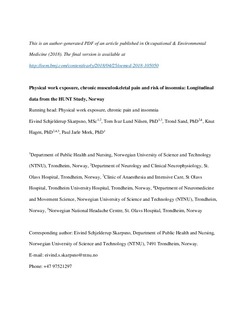Physical work exposure, chronic musculoskeletal pain and risk of insomnia: longitudinal data from the HUNT study, Norway
Journal article, Peer reviewed
Accepted version
Permanent lenke
http://hdl.handle.net/11250/2497085Utgivelsesdato
2018Metadata
Vis full innførselSamlinger
Originalversjon
10.1136/oemed-2018-105050Sammendrag
Objectives To prospectively investigate (i) the association of physical work demands and work-related physical fatigue with risk of insomnia symptoms and (ii) if these associations are influenced by chronic musculoskeletal pain.
Methods Prospective study on a working population of 8563 women and 7598 men participating in the Nord-Trøndelag Health Study (Norway) who reported no insomnia at baseline in 1995–1997. Occurrence of insomnia symptoms was assessed at follow-up in 2006–2008. A Poisson regression model was used to calculate adjusted risk ratios (RRs) for insomnia symptoms with 95% CI.
Results Compared with workers without work-related physical fatigue, women and men who reported that they were always fatigued had RRs of insomnia of 2.34 (95% CI 1.72 to 3.18) and 2.47 (95% CI 1.59 to 3.83), respectively. Overall, physical work demands was not associated with risk of insomnia, although men who reported heavy physical work had an RR of 0.67 (95% CI 0.47 to 0.97) compared with men with mostly sedentary work. Compared with the reference group of workers without work-related physical fatigue and no chronic pain, analyses of joint effects showed that women with excessive work-related fatigue had an RR of 4.20 (95% CI 2.95 to 5.98) if they reported chronic pain and an RR of 1.67 (95% CI 0.87 to 3.18) if they did not. Corresponding RRs in men were 3.55 (95% CI 2.11 to 5.98) and 2.13 (95% CI 1.07 to 4.25).
Conclusion These findings suggest that there is an interplay between work-related physical fatigue and musculoskeletal pain that should receive particular attention in the prevention of insomnia in working populations.
